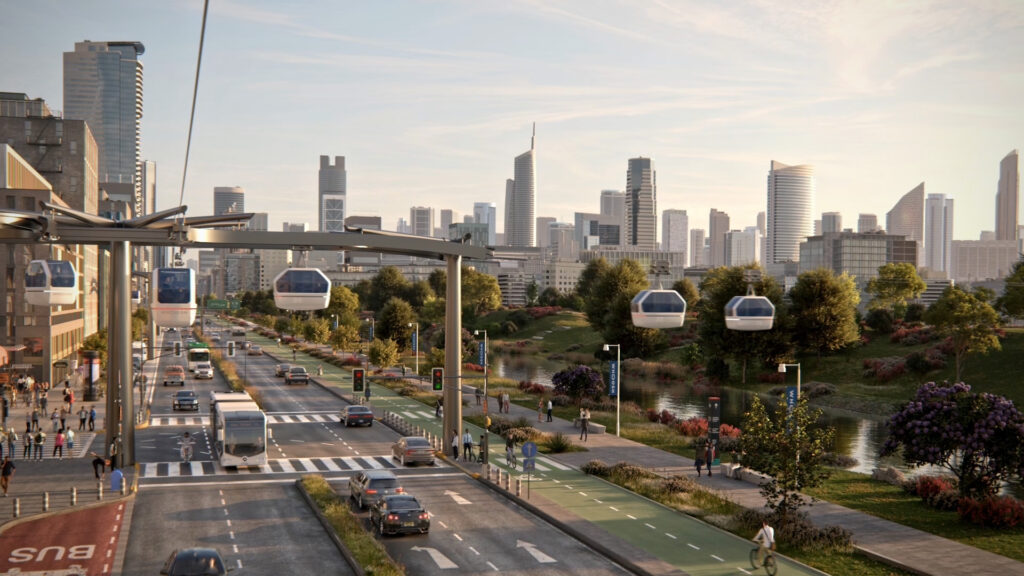In my earlier post about the Whoosh elevated autonomous cable car project in North Texas, I got a comment from Leonard Lee addressing some of the concerns I had raised. He invited me to contact him if I had any further questions, and well, I had them and so I did. The following is the brief Q&A I had with Leonard Lee, who is the Head of Communications for Swyft Cities, the independent business spun off from a Google project to do transit innovation. They are the sponsors of the Whoosh project. Here’s the Q&A:
1. The story I referenced only mentioned the five North Texas cities as being candidates for this pilot program. What other cities (if any) are also under consideration?
We are in discussions with cities and real estate developments around the world, but we’re particularly excited to be working with the five cities in North Texas, because North Texas has a long history as a center of transportation technology innovation. In addition, the CERTT program (Certification of Emerging & Reliable Transportation Technology) through the North Central Texas Council of Governments is a unique program that helps facilitate and streamline our discussions with the North Texas cities that are most interested in exploring new transportation technologies including ours.
2. Are the five North Texas cities being considered as a group, or are they competing against each other? How many grants will there be in the end?
We are having separate discussions with each city to identify the best site for the first pilot project, but we are hoping that multiple projects will result from the process.
As far as grants, that’s part of our discussions with the cities. but the grant process always carries a lot of uncertainty, so although we are hopeful, there is no way of knowing in advance how many grants might be involved.
3. What is the time frame for making a decision? What is the time frame for construction?
There is no set timeline for making a decision. We want to be thorough and work with the cities to identify sites where we have the most impact to address their transportation needs. But we are hopeful that in working with the cities we will have a list of candidate sites identified by the end of this year with selection of the first pilot site by mid-2025. The next phase after that would be engineering planning. Once construction starts, build time for the first pilot system is expected to be no longer than 18-24 months.
4. What are the criteria for the success of the project, and is that solely determined by Swyft Cities or do the participants have a say in it?
Each city may have different goals for what they would like the pilot system to achieve. Some may want to ease traffic congestion in areas where cars need to be used even for short trips. Or they want to connect neighborhoods that are cut off by freeways or other obstacles. Improving access to DART transit is likely to be an objective. Others may want to improve opportunities to develop new real estate by planning in new mobility options.
5. What happens to the infrastructure after the pilot?
The pilot system is intended to the initial phase of a system that can be continually expanded over time. We see one of the benefits of our system being that it is easily expandable.
6. By the nature of this technology, I assume that it can’t be extended to a greater area in the way a bus network can. If the goal is to make mass transit work better, is the idea that there could be several discrete installations in different city hubs?
Great question. Our system is designed be very flexible in how networks can be built. We sometimes liken it to building a transportation system like Legos. It could be a series of small networks built around existing transit hubs. Or it could all be stitched together into larger networks. To extend the Lego analogy, there’s almost no limit to how large a network could be built or how it could be configured.
7. Most large scale transportation projects have to go through environmental impact reviews and other time-consuming processes. Are there similar requirements for this project, either in the pilot phase or later in a full production phase?
Absolutely. As you mention, environmental review is part of any large infrastructure project, and we working with the cities on those processes.
8. Are there other pilots planned? What would a city need to do to participate in a subsequent pilot?
A hardware pilot system will break ground in New Zealand in coming months. Our discussions with cities in North Texas are for the first U.S. pilot system.
My thanks to Leonard Lee for his (very quick!) responses to my questions. I’ll be keeping an eye on this and look forward to seeing how it turns out. Honestly, I’m a little jealous this is happening in the Metroplex and not here. Not that we’d be serious contenders given current conditions. Maybe someday down the line if this works as intended.

